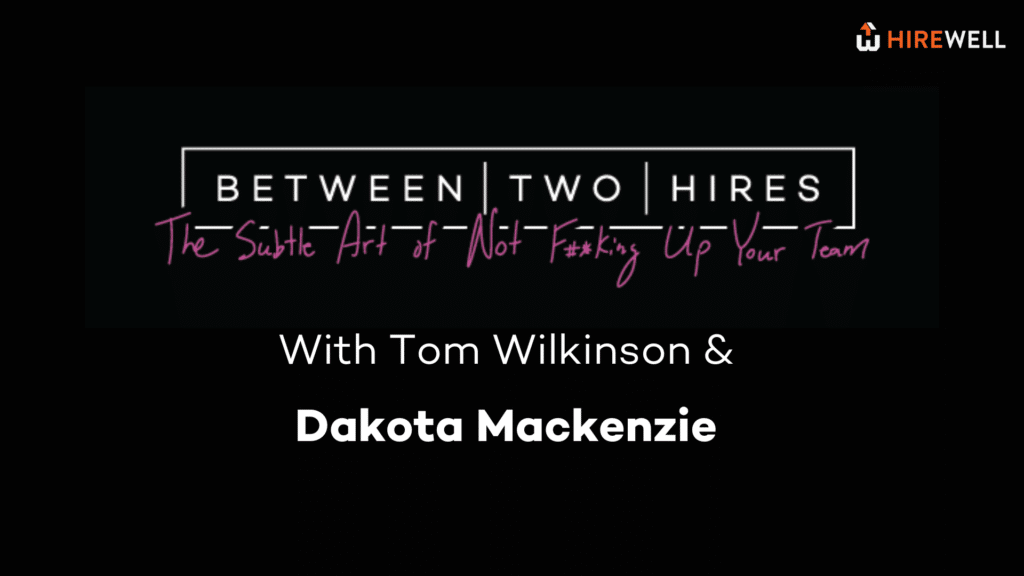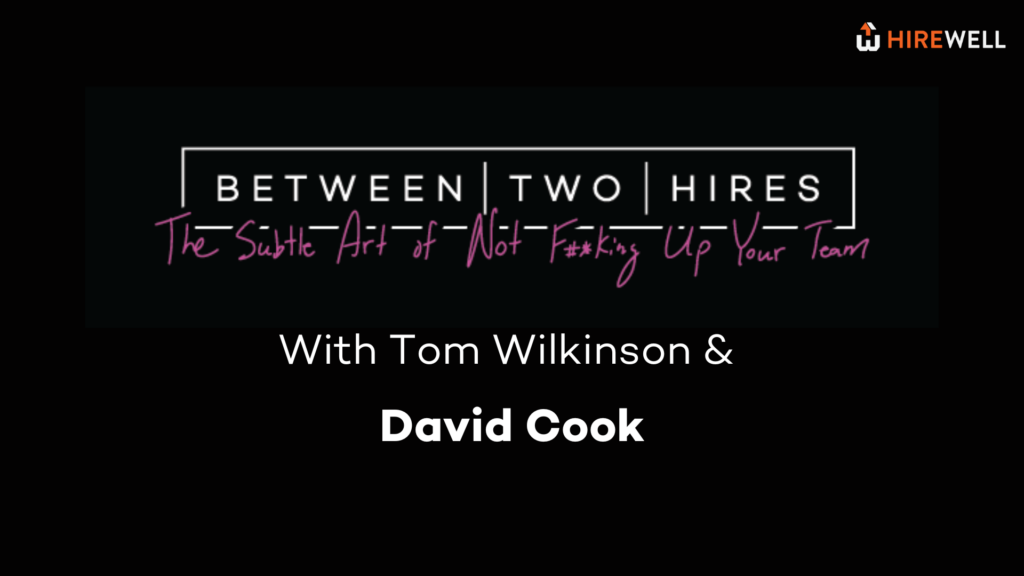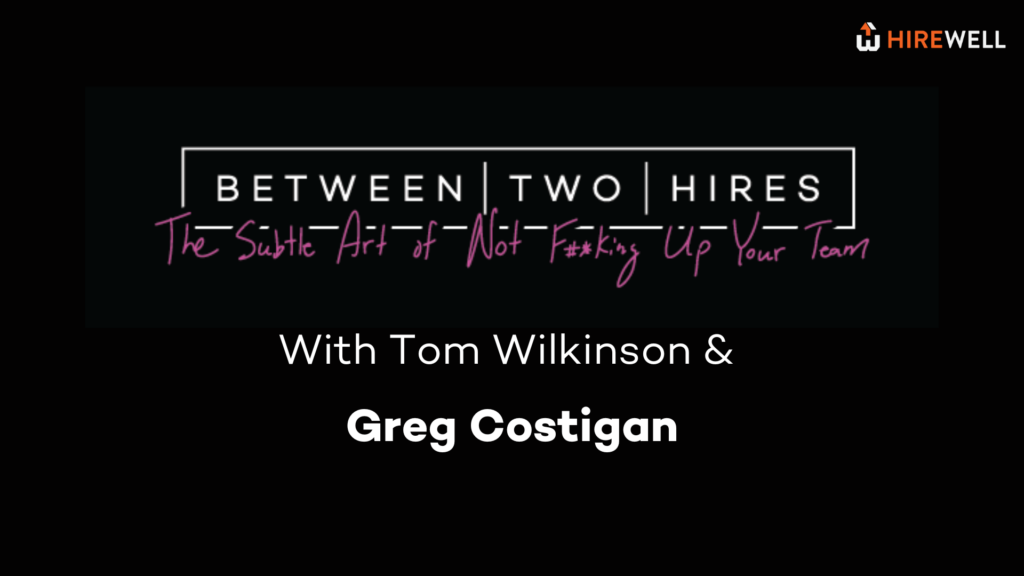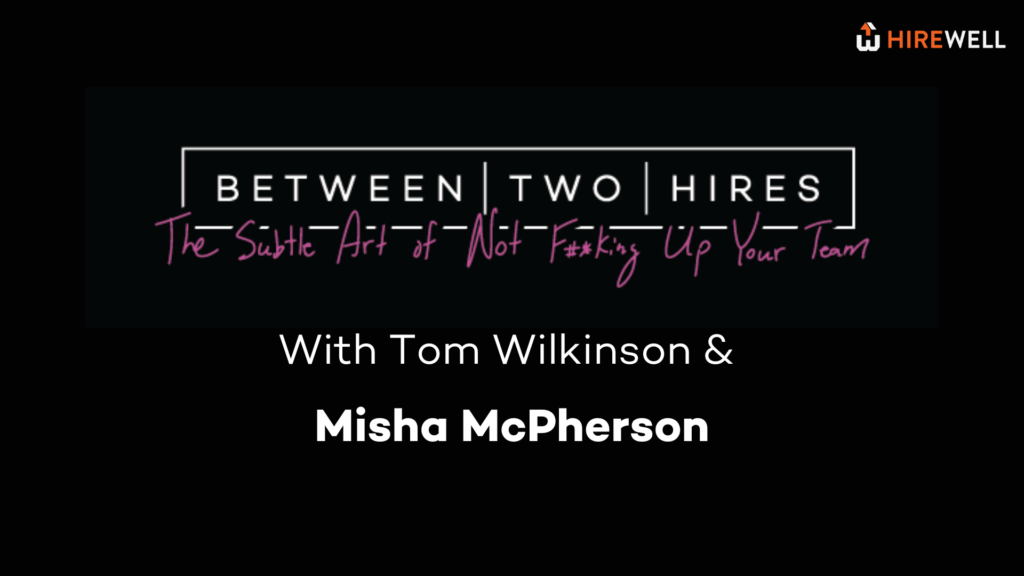In episode 2 of Between Two Hires (The Subtle Art of Not F#*ckin Up Your Team), Matt Cameron and Tom Wilkinson talk about Matt’s stories of his best and worst hires, the importance of diversity in reference checking, secret recruiting tactics, unconventional interview questions, and the most important wisdom he wishes he knew earlier in his career.
Episode Transcript
Matt Cameron, very, very good to see you. It seems like I’ve outbalded you today a little bit. Yeah, yeah, I know. I’ve got to sort that out. I am feeling a bit fuzzy. Very good to see you. Thanks for spending some time here. So we know each other from the Commonwealth, of course. Bald Brothers too, but Kahuna was where I think we first crossed paths.
And you’ve gone on to do some pretty wonderful things since then. It seems that a lot of the folks I know, know you and you’ve worked with them in some capacity over these years. But yeah, if you would, please, feel free to introduce yourself and a bit about SaaSy sales leadership and what you’re doing there.
So yeah, that was 2015 we got to know each other and in 2016, I launched SaaSy Sales Leadership, which is a company that is focused on building the frontline management and senior leadership capacity in primarily venture and PE backed firms. So we work with folks that have stepped into the role for the first time and need to understand the foundational competencies you need in the front line, things like code coaching, pipeline inspection, what does an accountability one on one look like, how do you get feedback, all that good stuff.
And then we work with some senior leadership who actually want to put in place a sort of a structured operational cadence for all of the managers. So everyone’s doing things the same way. And the one thing we do that is a little bit different is that we incorporate emotional intelligence assessment and development as part of that.
Because one of the hardest things to do, as any people person or person responsible for people, is to manage yourself, your self awareness, and your emotional expression as you go through the trials and tribulations of being a leader in the tech industry. So that’s what we do. Wonderful.
And might I add, anyone that hasn’t crossed paths with Matt Cameron, you really should as soon as possible. So do reach out. All right, Matt. Let’s have some fun, right? This is a, I think an interesting few topics that we’re covering here and looking to bring some insights to. But I already know your sort of credibility knows no bounds, but in terms of the numbers, let’s talk about it.
How many have you hired for in the course of your career? Yeah, so I’ve had a very, I want to give some context before I give specific numbers because I think it’s important. I started hiring in 1996, which was the first company I founded. It was called, Convenient Cuisine, which was Uber Eats before there was widespread internet at home.
So, I’ve hired almost any roles you can name in the areas of food delivery, vocational training, I owned a sports college, consulting, and of course software, which is the primary, the weight of my career. But if you just count the people I’ve directly personally interviewed, I was thinking about it before we chatted and it’s in the region of 90 to 100 of people that I’ve personally interviewed and the rest we’ve had many more under my, in my orgs that have been interviewed, but I didn’t
directly interviewed them, my delegates did. And I kind of laugh because sometimes I see on LinkedIn people say, you know, they’ll be in their mid career and they’ll say, “I’ve interviewed hundreds of people.” I’m like, unless you’re a recruiter, that’s BS. Like it’s just not reality. So I think that 90 to a hundred of direct interviews is about realistic for me.
Very good. Very good. So it seems like you definitely have a say on this. So I’m interested to just to understand a bit about the stories of maybe your best and worst hiring surprises. Yeah. Best hire, was a little predictable. I’d like to share this story because he was a guy who’d worked for me before and I rang him up, just taking a VP, the Kahuna role, just taking the VP sales role and he’d worked for me at Yammer and I couldn’t find him anywhere.
And so I tracked him down on Facebook messenger, of all places. He took the call and he answered it with a beard that would have probably come down to his belly button. He looked like a sage and he explained that he was on the Annapurna trail with three days to get to the top and back. And I think it was like a Wednesday and I said to him, “I’ve got a sales kickoff on Monday, and it’d be really good for you to be at that because I need you to come and lead and build a business development team. It’d be shame if you’d miss it.” He decided to run the trail up and back and did it in around a day instead of three. He got down to Nepal. There was a public transport strike.
So he bribed some guy to drive him through this and get back on time, clean shaven for Monday. And I like to tell that story because it kind of, it represents who this guy is. And so there’s an example of someone, if you want commitment, grit, determination, like that was demonstrated. And it was an easy hire, of course, cause I’d had them before.
So the only learning you can take from that is there are some people that have just got it and you can find evidence of it. And there’s a fun example. But another one, which I think is a fun, great, like possibly the best enterprise sales hire I’ve ever made. I was at Salesforce and we’re competing with Oracle and Microsoft for a 1.8 million CRM deal. And I felt very confident that we could win this deal. The opposing rep at Oracle, I do opposition research in really large deals. Like who are we competing with? And I found out this guy, his name was Aiden. He was an absolute legend. I was like, okay, I want this guy.
So during the bid, I said, hey, I rang him up, surprised the heck out of him. I said, we should go for lunch. And he’s like, should we? I said, yeah, we should, we need to talk. And anyway, we had lunch and mid bid, you know, this is a six month sales cycle, right? RFP, all that sort of stuff. He decided to join us.
He’s so good and so high integrity that Oracle said, you’re going to finish the bid. So he rang me up and he said, I just want you to know, I’m going to do everything I can to beat you in this deal. And then of course, I’m going to join your company. And I was like, okay. High integrity. We got him, wasn’t his fault.
He actually qualified out of the deal, but was still in it. He said to Oracle, we should not be in this deal. But I just love that integrity. And, you bring a guy like that into the business and you know, they’re going to do the right thing every time. So that was a fantastic hire. Astonishing.
So two things, climb to the top of the mountain and then interview with you on a Monday. And then go head to head in a deal and then join you after it. Yeah. Do you want to hear it? Because that makes me sound smart at getting a good P. Would you want to hear like the worst hire? Let’s go. Of course. So I’ve got a couple of examples, but for the sake of time, I’ll start with one.
You let me know if I’ve got time for another. So, I actually didn’t directly hire this person, but I was on the hiring panel. So when I work with organizations now, they often ask me to be sort of a final filter on certain things, especially earlier stage. And so we had this guy who was my age, I’m 50.
So he would have been at that stage, probably, late 40, something like this, a very tenured enterprise person. We brought him in and within a month we realized that he was a terrible chauvinist, just horrible. And so of course, you know, we out. But then I turned to the leadership team, I was like, how the hell did we miss this?
Let’s look at the references we did to find out how we could have missed this and let’s improve our process. And what I found was, and this was about seven years ago, I guess it was pretty early when we’re doing this stuff. And I realized with all the experience I had in hiring these people, I’d never thought about diversity in reference check.
I never thought to make sure that say for a Caucasian male that I would want to speak to people, persons of color, female identifying, you know, to see what it’s like to work with that person. Because technically he was excellent. And now whenever I teach and train, I say diversity in reference checking, diversity in reference checking.
So when you were speaking to Harvey Weinstein about his reference, that didn’t signal some kind of alarm bell? Amazing. So diversity of- so diversity of reference checking. That’s really interesting as a concept. I’m not sure that people are thinking about that out there. I don’t think so. I think they’re thinking about peers as a minimum, direct leadership, ideally someone at the C level.
But not sort of filtering down into diversity there to understand what they’re like outside of the job itself. Yeah. I always check. I always ask for customers too. Right. And the question I ask of customers is, if this person was representing a product or solution that would be useful to you in the future, why would you prefer to buy from them over anybody else?
What’d you get from that? Really? So every- if I just asked them, would you buy from them again? They would say yes, because they were a reference, right? I find out what’s truly valuable and what I’m listening for, a hundred percent top marks is they helped me and they helped me uncover an unknown that needed to be solved, made me look smart, avoided an issue. Is there anything else you look for here? Because I think, I mean, I just want to stay on this for one second, because I think what you’re saying is phenomenal. Is there anything else that you go into there? That’s top marks, but sort of the ticket to the game is that they came in and were a thought partner to me in solving a problem and did it in a way that I couldn’t have achieved by myself.
That’s what I’m looking for. Because if everyone’s got the same product and the solution and you become a thought partner to them and open the lens that they’re looking at this problem through, then you’re going to win because then you can change the criteria. You can change priorities and of course, you’ve got the interpersonal relationship.
Very, very nice. Yeah. Thank you for that. Okay. So secret weapons. Specifically secret recruiting weapons to source top talent. If I tell you it’s not secret. I’ll keep it to myself. All right. If your promise is just between us boys, all right, great. So it’s pretty straightforward. Keeping a list of talent.
But let’s be tactical. Back in the day, Linkedin used to allow you to tag people. So whenever I met someone or spent time with them, I would create a custom tag that said CSM talent, management talent, strategy talent, you know, whatever talent, and therefore, when I was looking for someone in the future, I could just do a filter and find them.
So now there are lots of ways to do that now. You can do it with navigator. You can do it with other tools, but have a place, a repository where you can quite quickly and easily find people that have specific skills, because it’s useless to go to my 10,000 LinkedIn connections and say, an enterprise AE. I’ll get 500.
I mean, it doesn’t matter. So I tag, I have people that I’m like, aha, that’s a person that I would recommend in the future. So one of my clients says, “Hey, I’m looking for a mid market enterprise and a mid market manager that has these skills and experience in this place.” I can just filter and find them. So it’s extremely tactical.
You need to do that. But then the other thing that everyone forgets to do, is for people that are very high value in your sort of recruiting future, you need a recurring reminder to touch base with them. So again, I’ll be very tactical for a second. It doesn’t matter what your CRM is or personal management system.
I use Salesforce. I have a report called important people. And I have a date for when I need to check in with them. And every single week it tells me who I’m due to connect with. And many of them are not just customers, but to your point, recruiting talent. And I’ll send them something interesting based on what they’ve been up to, or just a, “Hey, I was thinking of you, blah, blah, blah.”
And that way, you don’t want it to be, “I haven’t spoken to you in three years, but hey Matt, I’ve got this great job opportunity for you.” It’s not going to work. It might. Rarely. How do people make it to that coveted list, Matt? Now that I’m not going to share. Okay. For another time. Weird and wonderful things happen in recruitment.
We know that much. Can you tell me the weirdest interview moment you’ve experienced? Well, I thought about this. I have a longer story if we have time, I can share it, but the short story is this: it wasn’t me directly, but I got a secondhand review of it. My friend and I, a colleague and I recommended this person who was a BDR manager, who wanted to transition into enablement for a role.
So there’s a bit of social capital that’s at risk here, right? We’ve recommended this person, yadda, yadda, yadda. The interviewer reported back that through the video interview, they noticed the candidate seemed distracted. Turns out he was watching sports or something on a second screen. And this is the kicker, had a beer in his hand.
I kid you not, you couldn’t make it up. And so it’s like, really? So that was probably the most weird story I’ve heard about a specific experience. It was just nice. Beer in hand. It’s brave. We funnily enough, experienced something very similar. The guy had a beer cozy and he had a Bud Light in his hand.
And he was also wearing a wife beater at that time too. So needless to say, we placed him with one of our best clients, but yeah, never fails to surprise. So what about a secret or unconventional interview question or tactic that you have? Yeah, I don’t mind sharing this. So we teach, I teach to everyone I spend time with, while recruiting.
So I do spend time with teams. In fact, just today I do train folks on behavioral interviewing and I often do mock interviews with them. I pretend to be the candidate. It’s possibly one of the favorite things I do in my role. It seems silly, but I really enjoy it. One of the questions I teach them to ask is, “Have you ever had a roti bread?”
The Indian bread, roti? Yeah, so it’s a convenient acronym, ROTI, which, and I’ll say to you. I’ll say, Tom, I’ve really enjoyed this. I’m leaning into the opportunity to work with you in the future, but I want to make sure this is the best place for you to be at this stage of your career. So help me understand, from your standpoint, how can I make this the best return on time invested for you?
And so that I always give the pause and I say, take your time. And so what I’m listening for is what are they looking for from me as a manager and from the company? So I remember distinctly one person said, “Well look, I know I need to get up to speed and whatever else, but in 12 months time, you know, I want you to have me ready, develop me and have me ready for a frontline manager role.
That’s what I want to do.” And I was able to say, I appreciate that. And I think you’d be amazing, but the opportunity here is not going to be that quick. So we could cut it off. I can’t give you what you need because the last thing I want is a person we’ve invested nine months and 12 months in development to leave because we’re not giving them what they need at the stage of their development.
The second part of it is, if there is compatibility, then I can win their heart and their mind by saying, that’s fantastic. You want to do ABCD. Here’s how we’re going to do that for you. And lean in. I got one more, I got one more. Bonus one. I’d say Tom, I know this is very unlikely, but if you can just project in your mind 12 months ahead, you’ve joined our organization, you decide to leave.
What is the most likely context or situation that would have you leaving in 12 months?
It’s sheer brilliance. What do you hear? The bad answers are, my territory got cut and I don’t think I can be successful. Okay, cool. What I’m listening for and what I want to hear is, we’re not fulfilling the customer promise. I just, I really care about what I’m representing to my customers.
Okay, that’s good. Second one is, the culture as described isn’t real. And that you told me and I’ve talked about A, B, C, D things being really important to me from a cultural and value standpoint. And if that were to change and were true, then regardless of whatever else is going, how successful I’m being, it’s important to me that I’m part of a culture that I think is healthy and represents my values.
Those are the two best answers and that’s what I’m hoping to hear. You know what I’ve heard once? I’ve heard only once and it sounds like I’ve heard it once in real life, which is, “Well, you know, if I got a crazy good offer from somewhere else, I’ll be stupid not to take it.” I’ll be awesome. You know what?
You will get a crazy stupid offer. It probably is crazy and will never happen. Go chase that because someone will always pay you more money. It’s a preventative question, circumnavigate issues, scenarios that inevitably are going to happen down the road ahead of time. Yeah. Phenomenal. Very, very cool.
Let’s finish up with the most important piece of wisdom on hiring you wish you knew or had known earlier on in your career. Again, very tactical and hopefully people can apply this. What I found is, especially using applicant tracking systems or whatever else, it’s a completely subjective rating system that doesn’t allow us to compare candidate to candidate or defend my perspective.
So what I learned over time is describe the competency you need, right? And once you understand the competency, describe what that would look like if you were observing them doing it. So for example, you need to be a person who’s done enterprise sales that requires nine months where the multi stakeholder blah, blah, blah.
Okay, cool. What is the question I could ask to prove that I could see you doing that in your past? Right? And whatever that question happens to be. Now I need a score and you get zero if I’d never seen them do it and they didn’t meet the two or three things. You get a five, if they’re half of it, but they weren’t very successful or some combination. And you get a 10 if A, B, C, and D are true.
Now, very few organizations do that. And there are two things I see. I see the thumbs up, thumbs down, completely useless. And the second thing I see is a likert scale of one to five. But the problem is Tom, your three is my five because we haven’t defined what a three is. So if I could change anything, I could get everybody to do the same thing.
I would want them to define what must be true to get each of these scores. So when I have Sarah, Sally, John, and Nicole compared, I can quantitatively compare them and defend any decision we make. And then why is it important? Because in 12 months time, I find out that Nicole was extremely successful in our organization.
I go back to the scores and go, what did she have that no one else had or she really excelled at and I want more of that. Very, very nice. Matt there are levels to this game and I see you as someone who’s operating at the highest. I want to thank you for your time and wisdom and insights. Blew me away with some of these.
Thank you very, very much. It’s been my pleasure Tom. Anytime. Always great to see you and spend time.

















